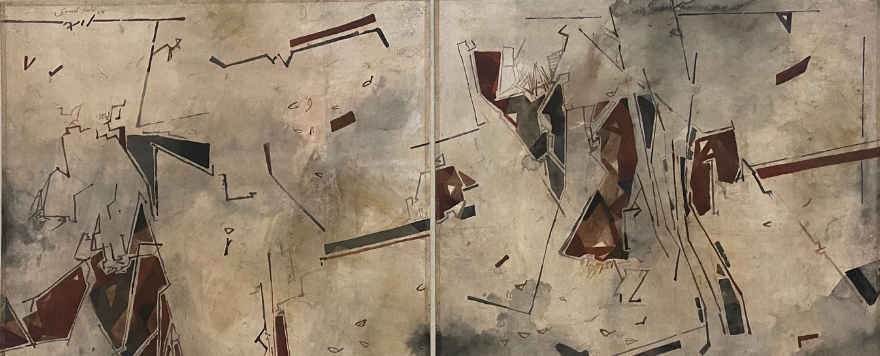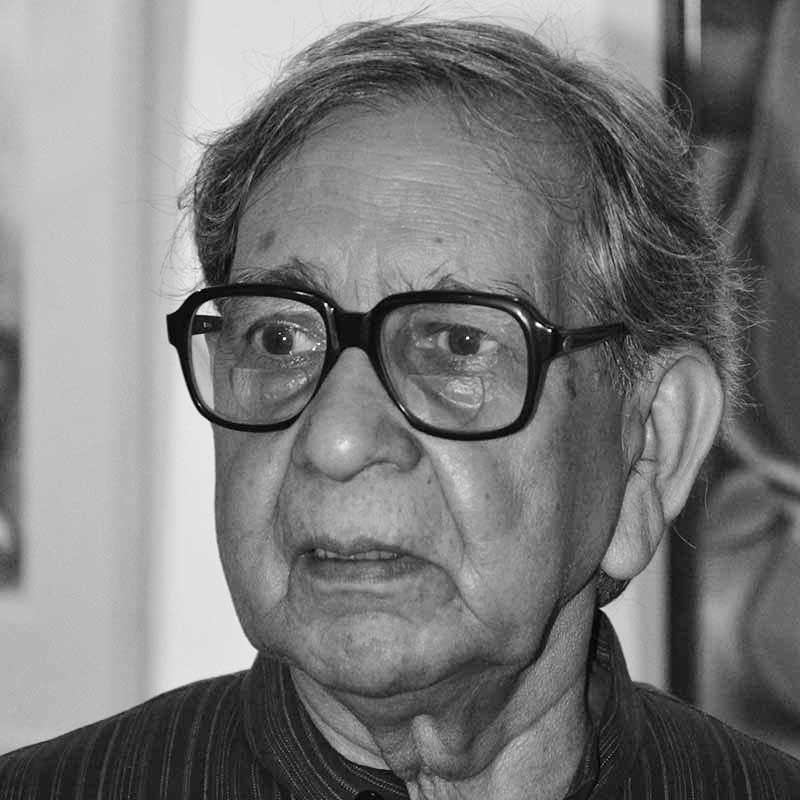
Ganesh Haloi’s major exhibition ‘Re-citing Land’ marks his artistic journey through six decades of painting. Haloi, who defied genres such as abstract, landscape or figurative and the notion of a single style, has been enjoying his continually evolving practice, where each painting is both, a discovery and struggle.
Ganesh Haloi is one of the lone artists from his generation, who painted without being tied down by the compulsion of literally representing reality, whose works carry the essence of in-translatability. A life rich with migration experiences and travels that inspired corporeal and noetic shifts, Haloi’s artistic pursuit began with mindful observations of idioms of the cultural past in Mughal miniatures and the Ajanta murals, in contrast with harsh realities in Kolkata (Calcutta) post-partition and the Independence of India. Inspirational stories of precursors and masters like Abanindrananth and Gopal Ghose, shaped his language as a young artist, which later evolved along with associational working process drawing from modern Bengali poetry of the 1950s.
The mighty Brahmaputra river and her various moods, the marshy land and rich aquatic life would remain as mnemonic fragments whenever Haloi reminisced about his house on the riverbank in Jamalpur. The childhood memory of water entering the aangan (courtyard) with overbearing force during inundation was especially rooted in him and his later works. Haloi’s visual imagination stretched this primordial form of spatial enclosure into an expansive field, with the closed boundary left broken or incomplete, allowing recollections to flood in.
In his minimalistic works, one can register an orchestration of formal elements not laid out for simple delectation but posing new problems. Interpretation of colour pigment on paper, with the complex methods of layering them on the surface, appear as explorations he made in a playfully decentered world. Resonating with the artist’s practice, curatorially, the exhibition is conceived as a kaleidoscope, evoking Haloi’s inscape of shifting configurations and vantage points.
- Roobina Karode, curator of the exhibition
Exhibition catalogue: Re-citing land | Ganesh Haloi: six decades of painting
Price: 850 INR (Shipping cost not included)
2023 | 27 x 23 cms | Paperback | 94 pages
ISBN: 978-81-957115-4-3
To purchase: Write to us at connect@jnaf.org

Ganesh Haloi was born in 1936 in Jamalpur, Mymensingh (now in Bangladesh), but he moved to Calcutta in 1950 following the Partition of India. The trauma of exile influenced his work, as is noticeable of other painters from his generation. Since then, his artwork has expressed a harmonious quality, combined with a profound nostalgia for a world that no longer exists.
In 1956, Haloi graduated from the Government College of Art and Craft, Calcutta. He then joined the Archaeological Survey of India as a resident artist, where from 1957 to 1963, he was assigned to produce copies of the Ajanta cave paintings. Haloi returned to Calcutta in 1963 where until his retirement, he taught at the Government College of Art and Craft. He has been a Member of The Society of Contemporary Artists, Calcutta since 1971.
Haloi’s earliest works include the study of miniatures at Banasthali (Rajasthan) and the replication of Ajanta frescoes for six years. He started his artistic practice in the 1960s, primarily as a landscape artist. By the mid 1970s, Haloi had become known for his skill in producing landscapes, which provided insight into the intangible. His time at Ajanta inspired him to study Buddhism, and research the techniques presented in the Ajanta murals. His realistic landscapes began to transform into non-representational scenes. The picturesque landscape of his hometown, pre-Partition, influenced the greenery and moisture-ladened lands in his paintings.
In the most poetic manner, Haloi began to portray nature going well beyond any visual documentation. ‘I try to fit the irregular movements of life into the artificial boundaries of the paintings,’ Haloi says. His use of colours is thick, evoking a thoughtful reminiscence with spontaneous ease. Throughout his work, Haloi strove to develop a sublime conversation between the land, sky, air, and water, without a trace of human presence.
Despite their abstraction, Haloi’s works and motifs consist of precise associations to his psyche, experiences, and the upheavals that have shaped both him and his point of view. These ‘innerscapes’ reflect his introverted and philosophical temperament, and show his significant contribution to the building up of the abstract trend in contemporary Indian art.
Haloi has won several awards including the Late R. N. Chakraborty Memorial Gold Medal from the Government College of Art, Calcutta in 1956, seven silver medals from Calcutta University and seven gold medals from the Academy of Fine Arts, Calcutta. He has participated in a number of group exhibitions in India; Documenta XIV in Athens, Greece and Kassel, Germany; ‘Architecture of Life,’ at Berkeley Art Museum & Pacific Film Archives at BAM/PFA, Berkeley, California; 8th Berlin Biennale for Contemporary Art, Berlin; ‘A Special Arrow Was Shot in the Neck,’ David Roberts Art Foundation, London; and ‘Over the Edge, Crossing the Line: Five Artists from Bengal,’ at KNMA, Delhi.
Haloi is represented by Akar Prakar Calcutta and New Delhi, and has had numerous solo exhibitions in Calcutta, Delhi, Bombay, Dhaka, and New York. These include ‘The Architectonics of Form’ at Akar Prakar Calcutta and New Delhi, 2022 and ‘Form & Play’ at Asia Week, New York, 2020. Recently, Haloi has also exhibited at The Jehangir Nicholson Art Foundation in a show called, ‘Re-citing Land,’ in collaboration with KNMA, Delhi, 2022. He lives and works in Calcutta.